A Different Approach to Evaluation in Early Childhood Curriculum: Learning Stories
Abstract
:1. Introduction
- Writing the story: The child’s actions, words, tendencies, and strengths during events should be observed. Notes should be taken, and photographs, videos, and documents explaining the child’s process should be prepared. Using these, the teacher should turn the child’s learning process into a short story describing the learning process. Then, they should find a creative title.
- Reading the story to the child: It should be ensured that the child’s own learning adventure, the story penned by the teacher, is shared with the child. The child’s feedback on the story should be obtained. If the child agrees, the story should be shared with the other children in the class. Sharing the story in this way can be helpful in motivating other children or creating different ideas.
- Planning: After the observed learning process and the written story, the teacher should consider what the child can do to improve their play and make progress developmentally (Are you going to add different materials? Will you change the material quality? Will you add research books, atlases, or picture storybooks?). Then, the teacher should record their thoughts as short-term and long-term goals. This will help with the preparation of the next learning story.
- Connecting to families: It should be ensured that the learning stories, which aid in the identification of goals for the child, are shared with the families, and that their views are also added to the story. These stories can be delivered to the families from time to time with a note or during an interview, and the comments of the families should be carefully examined. This way, developmental goals can be supported at home as well. It is important to try to improve cooperation with the family.
- Individuality: Since individual interests and characteristics are taken into account in learning stories, it can be used to explore and develop children’s individuality.
- Dialogue: Since individual interests and characteristics are taken into account in learning stories, it can be used to develop dialogues between parents, children, and teachers.
- Self-reflexivity: It can be used to encourage children to reflect on their own learning.
- Resources: From all assessments and observations made for the child, his or her strengths have been engraved and made available for emphasis.
- Learning tendencies: By focusing on positive developments, observations can be made to develop children’s learning tendencies and to prepare the next steps accordingly.
- Holism: Instead of the fragmented developmental evaluation of the child, a holistic evaluation that complements each other is aimed. No development is causeless and independent of any other.
- Storytelling: It can facilitate remembering events and making it easier for the child to notice. It is known that even when time passes, children do not forget the stories. In this regard, it can be ensured that children transfer their own experiences more easily by using their creativity.
2. Materials and Methods
2.1. Study Design
2.2. Participants
2.3. Procedure
3. Results
3.1. Planning the Learning Process
“In the preschool period, monthly learning processes are prepared in addition to daily learning processes. I prepare my monthly plan first and select some acquisitions and indicators according to the children’s needs. Afterward, I take care to address these in different activities by dividing them over the month according to various developmental areas. I make notes about whether these acquisitions have been achieved in the assessment section included in the observation part or under the activity plans. I do not write my observations in any other specific form. If something catches my attention, I take notes; I try not to forget it. I examine the acquisitions with a general observation and create the developmental assessment forms at the end of the semester. Other than that, I don’t use a different assessment method.”
3.2. Observation and Data Collection
“Making observations is a very open-ended concept in preschool. In my opinion, the open-ended nature of what will be observed or when it will be observed makes it rather difficult to use observation sometimes. After a while, making observations may be regarded as taking a glance, or simply watching children’s games. When observation is needed in my classroom, I sometimes have difficulties regarding whom to observe and how to make observations. I believe it would be sufficient to observe whether the child in question has acquired the acquisition indicators in the curriculum.”
| Photo(s) | Story |
 | Today we all went to the library together. UC, you love books, reading and anything related to books. Therefore, the idea of going to the library made you very happy and excited. I didn’t think there were many children’s books in the library, but I didn’t share this thought with you. You were very happy to be in the library but surprised that there were no children’s book in the library. You ran and started to examine the colorful books, especially the animals, on the shelves as in Photo 1. You started taking books that were interesting to you from the shelves and sharing them with your friends. It was very gratifying to see this. |
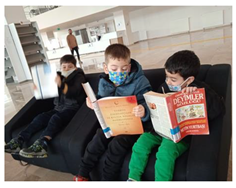 | While many of your friends were running around instead of spending time with the books, you were studying them with all your attention. You took a few books to share with your friends and ran to sit next to them. You can see it in the Photo 2. You handed over some books to them and you looked like as if you knew how to read. You started reading the sentences in the books and telling them to your friends (imitating reading). You tried to get the attention of your friends by showing them pictures. You can see this in Photo 3. |
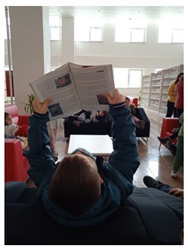 | The book in your hand talked about microbes and microbiological beings. You made explanations to your friends about them. For example, you were able to really explain what viruses are, how microbes feed, how they look. I am very surprised that you know all this. |
| Your interest in books never waned until you left the library. The book we read in class today when we came back from the library was a book you brought from home, and frankly, I was very surprised that you noticed this and recognized your book. You are a 4-year-old child who loves books and you are really interested in what is told in the books. I really liked seeing this. | |
| Learning Outcomes | Relevant Acquisitions and Indicators in 2013 Preschool Curriculum |
| Recognizes libraries. Knows what behaviors should be exhibited in libraries. Shows interest in books, examines them. Takes care to return the books in their places. | Cognitive Domain (A1, A2, A17) Language Development (A5, A8) Social Emotional Development (A4, A5, A10, A12) |
| Short-Term Goal | Long-Term Goal |
| To further develop U.C.’s interest in books, I need to get him to bring more books to the class for us to read and share with all his friends. I should take care to share these books with the whole class through reading activities. | Based on U.C.’s interest in books, I need to work to ensure he acquires more print awareness. Since he already has reading awareness, I think that the print awareness dimension can be acquired more easily. |
| Next Goal and Further Steps | Observer Notes/Assessment |
| Next week, I will ask UC to select and bring a book to use in reading activities with the class. | U.C. seems to be quite advanced in language development, especially in vocabulary (receptive language and expressive language). He turns out to be the best in the class in word count calculations and language development tests that I do in class. I think it’s because his parents gave UC a love of reading from a very young age, and they read a lot of books. U.C’s sophistication in language development often shows itself in the cognitive sense. In the following years, it can be discussed with his family about his taking the BİLSEM exam. |
| I will plan awareness activities for UC, starting with the spelling of its name and the letters/sounds in it. | His family needs to be supported so that they can continue to work on U.C’s print awareness at home. Meetigns should be arranged and information should be given on how to maintain this at home. |
| U.C’s opinions about the learning story | The family’s opinions about the learning story |
| Teacher, I liked the story very much. You wrote about me. I couldn’t read the books to my friends B.H and M.H, because I don’t know how to read. I just showed them the photos and told them about the microbes in the photos. I talked about the work of scientists. I wish there were children’s books in the library then I could talk about them as well. I could explain them about bacteria, organisms, with photos that were better suited to children. Because I love living things. | I’m so glad you discovered U.C’s interest in books. He has been introduced to many children’s books since his infancy. We take care to read him an average of 4–5 books every day. Now, the request to read a book comes from him, not from us. U.C tried to explain things to his best friends today, talked about books, and I think that made him very happy. When he got home today, his only complaint was that there weren’t enough children’s books in the library. I think it’s time we introduced him to children’s libraries. I had thought that he would not enjoy the library trip very much, but his interest in the subject made me very happy. |
| Photo(s) | Story |
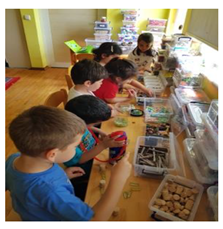 | Today, it was the day to make creative designs. We went to the loose part workshop in our school together. There you had the opportunity to freely examine and explore the materials and make the designs you wanted. You (UC) studied the materials really carefully with your friends. I think the place caught your attention. While you were designing, you were particularly interested in corks and you took a very close interest in them. You exchanged ideas with your friends and showed them the materials you chose. The screws of different sizes especially got your attention. |
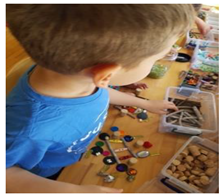 | You made your design using screws, beads, corks. You really like to make designs. I like it when you make an array and tell me about it. You designed some kind of vehicle during the activity today. This vehicle was a machine that could go back and forth, helping you with the housework when needed. You placed the beads and other materials one by one and they all had a task. I admired that you focused on your design so carefully and that you created a really different design. |
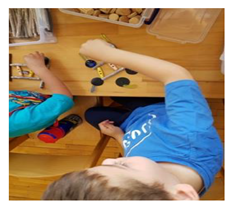 | While focusing your attention on your design, I saw that you were not influenced by other friends around you. You only cared about what you did. While developing something, you used the materials by counting them. You counted how many pieces of each of the materials you used. When you thought it was not sufficient, you utilized new materials right away. I think the important thing is that you took the selected materials as much as you needed. We continued creativity-based work in the classroom, and this time you designed houses using colored rods in the classroom. You did your design with Z.N. You discussed and decided with him and built two houses next to each other. In this process, you tried to help each other without raising your voices. I think the important thing in your design was that you first worked with 5 rods and then increased the number of these rods up to 10. You designed a chalet. You talked to me about your design and you told me you designed a house to put in your grandfather’s garden. You also put a lot of effort into the design of the house. |
| Learning Outcomes | Relevant Acquisitions and Indicators in 2013 Preschool Curriculum |
| Ability to express oneself in original and creative ways Ability to use different materials collaboratively Ability to create new and original products using materials | Cognitive Development (A1, A4, A6) Language Development (A5, A8) Motor Development (A4) Social Emotional Development (A3) |
| Short-Term Goals | Long-Term Goals |
| Considering that UC enjoys constructing buildings, it can be ensured that the designs include not only two dimensions but also the third dimension. Firstly, materials such as foam, blocks, paper rolls, and cups can be used to stack and build on top of each other. | UC’s family can be contacted to ensure that they continue building games at home. STEM activities can be done by taking advantage of UC’s interest in building construction. It may be possible for U.C to make designs in the future that combine toys (structured) such as lego, plug-in toys and materials from nature (unstructured). |
| Next Goal and Further Steps | Observer Notes/Assessment |
| For this purpose, foams should be put in the loose part workshop for U.C. so that he can build a structure using toothpicks and these foams. When he has better physical balance, the focus time will increase in games such as building construction. Therefore, the next goal is to improve balance and body coordination and to place some loose part building toys in the classroom. | I think U.C.’s creativity has improved significantly since the beginning of the term and he has come a long way. At first, he only was examining and mixing and matching the objects given to him, but now he can create some products using those loose part materials. He even gives names to these products or explains them to me. He can create a different product each time. I think the loose part activity is going well for all the kids, including U.C. |
| U.C’s opinions about the learning story | The family’s opinions about the learning story |
| Teacher, I love the loose parts workshop, it is fun to design there. I wish we always went there. There are shiny stones, beads, and many more. Yes, I had built a house. I also made a design. I’m going to show these to my mom. | UC has always told us that he loves the loose parts workshop at the school. Especially lately, I have been observing that he has been making designs with materials such as kneading materials, buttons and beads at home. He finds them and brings them to tells me about them. He recently made me the following designs. He said these were a snail house and a mandala. He had a bit of difficulty while making the mandala, but I supported him. Thus, we had some quality time together. The fact that he brings together unrelated and different materials to create something really impresses me.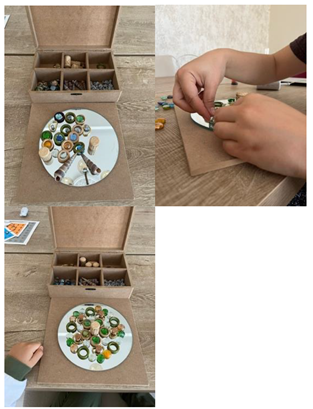 |
“When I first heard about the learning stories, it seemed to me as if it were a very hard method to apply in the classroom. Then I thought about the form given to me and started to make observations to apply it to my student. Frankly, these observations highly impressed me, because I knew my student U.C., but I realized that I didn’t know him that much when it comes to details about him. Thanks to the observations, I started to focus more on the capabilities and abilities of U.C. This was the aspect that I really liked.”
“I was exciting to gather the evidence to design the learning story. I realized that the pictures I took must thus have meaning. We take pictures of children in the classroom and sometimes we upload them to our web page or share them in communication groups, with the permission of the parents. However, I usually took these pictures to disseminate the activity. Thanks to the learning stories, I started taking photos to provide evidence for the observations about U.C. This showed me that the pictures I took could be more useful. While explaining the pictures, it became very easy to write the story.”
“I think one of the best aspects of learning stories is that they support you in communicating with the family. Thus, the relationship with the family starts to include more trust, because with learning stories, you write the story of the child and it is as if the family is experiencing what happens in the classroom through your words. Sometimes the family has important observations at home, and by adding their observations, the family contributes these observations to ensure that the learning story is multifaceted. Sometimes, these stories provide an opportunity for families to get to know their children better.”
“While writing the learning stories, filling in the section about the relevance for the MoNE program was the most challenging aspect for me. It was challenging to concretize the learning outcomes and write their relevance to the program, because although some observations are very valuable, they do not define a behavior or an indicator in the program. In this case, it is difficult to write this section.”
4. Discussion and Conclusions
Author Contributions
Funding
Institutional Review Board Statement
Informed Consent Statement
Data Availability Statement
Conflicts of Interest
References
- Carr, M.; Lee, W. Learning Stories: Constructing Learner Identities in Early Education; SAGE: Thousand Oaks, CA, USA, 2012. [Google Scholar]
- Eden, R.; Davis, K.; Wright, J.; Carr, M.; Peter, S. Key Competencies, Assessment and Learning Stories: Talking with Teachers and Students. N. Z. J. Educ. Stud. 2015, 50, 165–167. [Google Scholar] [CrossRef]
- Blaiklock, K.E. Assessment in New Zealand Early Childhood Settings: A Proposal to Change from Learning Stories to Learning Notes. Early Educ. 2010, 48, 5–10. [Google Scholar] [CrossRef]
- Knauf, H. Documentation Strategies: Pedagogical Documentation from the Perspective of Early Childhood Teachers in New Zealand and Germany. Early Child. Educ. J. 2020, 48, 11–19. [Google Scholar] [CrossRef]
- Grindheim, L.T.; Hadler-Olsen, S.; Ohm, M. Who is the troll?: Children as active learners presented as a learning story about the troll from a Norwegian barnehage. N. Z. Res. Early Child. Educ. 2010, 13, 71–86. [Google Scholar]
- Leu, H.R.; Fläming, K.; Frankenstein, Y.; Koch, S.; Pack, I.; Schneider, K.; Schweiger, M. Bildungs-Und Lerngeschichten; Verlag das Netz: Berlin, Germany, 2007. [Google Scholar]
- Arndt, S.K.; Tesar, M. Early childhood assessment in Aotearoa New Zealand: Critical perspectives and fresh openings. J. Pedagog. 2015, 6, 71–86. [Google Scholar] [CrossRef]
- Carr, M. Young children reflecting on their learning: Teachers’ conversation strategies. Early Years 2011, 31, 257–270. [Google Scholar] [CrossRef]
- Koch, S.; Nebe, G. Wie das Kind geschrieben wird. Lerngeschichten als Inszenierungspraxis in Kindertageseinrichtungen. In Inszenierung Und Optimierung Des Selbst; Springer: Wiesbaden, Germany, 2013; pp. 111–135. [Google Scholar]
- Liljestrand, J.; Hammarberg, A. The social construction of the competent, self-governed child in documentation: Panels in the Swedish preschool. Contemp. Issues Early Child. 2017, 18, 39–54. [Google Scholar] [CrossRef]
- Gould, K.; Pohio, L. Stories from Aotearoa/New Zealand. In Insights: Behind Early Childhood Pedagogical Documentation; Pademelon Press: Jamberoo, Australia, 2006; pp. 77–86. [Google Scholar]
- Zhang, Q. Advocating for a comprehensive approach to assessment in New Zealand early childhood education. N. Z. Res. Early Child. Educ. 2015, 18, 67–79. [Google Scholar]
- Carr, M.; May, H.; Podmore, V.N.; Cubey, P.; Hatherly, A.; Macartney, B. Learning and teaching stories: Action research on evaluation in early childhood in Aotearoa-New Zealand. Eur. Early Child. Educ. Res. J. 2002, 10, 115–125. [Google Scholar] [CrossRef]
- Wanoa, L.; Johnston, M. How the Learning Story Framework can be Enhanced to Provide Better Assessment Information to Support Planning for Children’s Further Learning: A Critique of the Reliability and Formative Validity of Learning Stories in Aotearoa New Zealand. N. Z. Annu. Rev. Educ. 2020, 24, 90–104. [Google Scholar]
- Carr, M. Assessment in Early Childhood Settings; SAGE: London, UK, 2001. [Google Scholar]
- Salcin-Watts, E.M. What Makes a Great Story? Teacher and Parent Perceptions of Quality Learning Stories in Early Childhood Education: A Thesis Submitted in Partial Fulfilment of the Requirements for the Degree of Master of Education at Massey University, Palmerston North, New Zealand. Ph.D. Thesis, Massey University, Palmerston North, New Zealand, 2019. [Google Scholar]
- Blaiklock, K.E. A Critique of the Use of Learning Stories to Assess the Learning Dispositions of Young Children. N. Z. Res. Early Child. Educ. 2008, 11, 77–87. [Google Scholar] [CrossRef]
- McMillan, J.H.; Schumacher, S. Research in Education: Evidence-Based Inquiry; Allyn and Bacon: Boston, MA, USA, 2006. [Google Scholar]
- Blaiklock, K. The assessment of children’s language in New Zealand early childhood centres. N. Z. J. Educ. Stud. 2010, 45, 105–110. [Google Scholar]
- Zhang, Q. Do learning stories tell the whole story of children’s learning? A phenomenographic enquiry. Early Years 2017, 37, 255–267. [Google Scholar] [CrossRef]
- Davis, K.; Wright, J.; Carr, M.; Peters, S. Key Competencies, Assessment and Learning Stories; New Zealand Council for Educational Research: Mount Victoria, New Zealand, 2013; p. 62. [Google Scholar]
- Aschermann, E.; Dannenberg, U.; Schulz, A.P. Photographs as Retrieval Cues for Children. Appl. Cogn. Psychol. 1998, 12, 55–66. [Google Scholar] [CrossRef]
- Reese, E.; Cleveland, E. Mother-Child Reminiscing and Children’s Understanding of Mind. Merrill-Palmer Q. 2006, 52, 17–43. [Google Scholar] [CrossRef]
- Takacs, Z.K.; Swart, E.K.; Bus, A.G. Benefits and Pitfalls of Multimedia and Interactive Features in Technology-Enhanced Storybooks: A Meta-Analysis. Rev. Educ. Res. 2015, 85, 698–739. [Google Scholar] [CrossRef] [PubMed]
- Southcott, L.H. Learning Stories: Connecting Parents, Celebrating Success, and Valuing Children’s Theories. Voices Pract. 2015, 10, 34–50. [Google Scholar]
- Cowie, B.; Mitchell, L. Equity as Family/Whānau Opportunities for Participation in Formative Assessment. Assess. Matters 2015, 8, 119–141. [Google Scholar]
- Alvestad, M.; Duncan, J. The value is enormous–It’s priceless I think New Zealand preschool teachers’ understanding of the early childhood curriculum in New Zealand: A comparative perspective. Int. J. Early Child. 2006, 46, 31–45. [Google Scholar] [CrossRef]
- Dunn, L.M. Using “Learning Stories” To Assess and Design Programs for Young Children with Special Needs in New Zealand. Infants Young Child 2000, 13, 73–82. [Google Scholar] [CrossRef]
- Nyland, B.; Alfayez, S. Learning Stories—crossing borders: Introducing qualitative early childhood observation techniques to early childhood practitioners in Saudi Arabia. Int. J. Early Years Educ. 2012, 20, 392–404. [Google Scholar] [CrossRef]
- Reese, E.; Gunn, A.; Bateman, A.; Carr, M. Teacher-child talk about learning stories in New Zealand: A strategy for eliciting children’s complex language. Early Years 2021, 41, 506–521. [Google Scholar] [CrossRef]
- Picken, A.; Milligan, A. The challenges of assessment in secondary social studies: Exploring the potential of learning stories. N. Z. J. Educ. Stud. 2013, 48, 112–129. [Google Scholar] [CrossRef]
| Activity | The Aspects That Can Be Observed |
|---|---|
| A trip to the library | Clues on their interest in books, their way of viewing books, their attention to pages, and reading awareness |
| Free play with natural materials | Creativity, motor skills in holding and placing materials, concept knowledge of color and shape, communication with peers, cooperation and harmony |
| Active games | The ability to use their senses, the development of touch, body coordination and sense of hearing, cooperation, participation in the game, obeying the rules, communication with their peers during the game |
| Reading stories | Focusing attention during story reading, answering questions, early literacy skills and awareness, self-expression, language development, communication, harmony with peers, paying attention to instructions |
| Art activity | Motor skills (small muscle), concept of color, following directions and harmony, working cooperatively with a group, unaided cutting and pasting using scissors |
Publisher’s Note: MDPI stays neutral with regard to jurisdictional claims in published maps and institutional affiliations. |
© 2022 by the authors. Licensee MDPI, Basel, Switzerland. This article is an open access article distributed under the terms and conditions of the Creative Commons Attribution (CC BY) license (https://creativecommons.org/licenses/by/4.0/).
Share and Cite
Cengiz, G.Ş.T.; Altındağ, A. A Different Approach to Evaluation in Early Childhood Curriculum: Learning Stories. Sustainability 2022, 14, 11218. https://doi.org/10.3390/su141811218
Cengiz GŞT, Altındağ A. A Different Approach to Evaluation in Early Childhood Curriculum: Learning Stories. Sustainability. 2022; 14(18):11218. https://doi.org/10.3390/su141811218
Chicago/Turabian StyleCengiz, Gülüzar Şule Tepetaş, and Ahmet Altındağ. 2022. "A Different Approach to Evaluation in Early Childhood Curriculum: Learning Stories" Sustainability 14, no. 18: 11218. https://doi.org/10.3390/su141811218
APA StyleCengiz, G. Ş. T., & Altındağ, A. (2022). A Different Approach to Evaluation in Early Childhood Curriculum: Learning Stories. Sustainability, 14(18), 11218. https://doi.org/10.3390/su141811218







